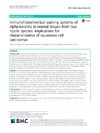Please use this identifier to cite or link to this item:
https://accedacris.ulpgc.es/jspui/handle/10553/41993
| Title: | Immunohistochemical staining patterns of alpha-keratins in normal tissues from two reptile species: implications for characterization of squamous cell carcinomas | Authors: | Orós, Jorge López Yánez, María Rodríguez, Francisco Calabuig, Pascual Castro, Pedro L. |
UNESCO Clasification: | 3109 Ciencias veterinarias | Keywords: | Alpha-keratin Bearded dragon Caretta caretta Immunohistochemistry Loggerhead Sea turtle, et al |
Issue Date: | 2018 | Publisher: | 1746-6148 | Project: | Optimizacion de la Rehabilitacon de Tortugas Bobas (Careta Caretta) Varadas Mediante El Estudio de Sus Glandulas Excretoras de Sal y de Pautas de Fluidoterapia Idoneas. | Journal: | BMC Veterinary Research | Abstract: | Background: Cytokeratins with epitopes in common with those of alpha (acidic and basic) mammalian keratins have been immunohistochemically demonstrated in the epidermis of reptiles. However, there are no reports of immunohistochemical staining patterns of alpha-keratins in other tissues from reptiles. Because the epithelial tumours usually retain the keratin patterns of their normal epithelial origin, it is necessary to know in advance these patterns in the major normal epithelia and organs. We used anti-alpha human keratin AE1 and AE3 monoclonal antibodies to study the staining patterns of alpha-keratins in the major normal epithelia and organs from two reptile species [the bearded dragon (Pogona vitticeps) and the loggerhead sea turtle (Caretta caretta)]. We also studied the immunolocalization of alpha-keratins in squamous cell carcinomas (SCCs) in a bearded dragon and two loggerhead turtles. Results Acidic alpha-keratin (AE1 positive) was detected in many of the epithelial tissues of the bearded dragons; however, the detection of basic alpha-keratin (AE3 positive) was much more limited. Alpha-keratins were detected in a greater number of tissues of loggerhead turtles compared with those observed in bearded dragons. In the bearded dragon SCC, all layers of the nests of neoplastic cells, including the cornified layer of the keratin pearls, were strongly reactive with the AE1 antibody. However, a weak reactivity using the AE3 antibody was detected in the basal and intermediate layers of these nests. In the cutaneous SCCs of both sea turtles, acidic alpha-keratin was detected in the basal and suprabasal layers, and in all of the invasive neoplastic cords, while basic alpha-keratin was mainly detected in the invasive neoplastic cords. The pattern observed in the metastases in both turtles consisted of immunohistological detection of acidic alpha-keratin in all metastatic foci, and limited or lack of detection of basic alpha-keratin. Conclusions This study provides, for the first time, information about the immunohistochemical staining patterns of alpha-keratins in normal tissues from bearded dragons and loggerhead sea turtles, and confirms the usefulness of AE1 and AE3 monoclonal antibodies in these reptile species. The use of these antibodies also contributed to a better characterization of SCCs in these species. | URI: | https://accedacris.ulpgc.es/handle/10553/41993 | ISSN: | 1746-6148 | DOI: | 10.1186/s12917-018-1545-6 | Source: | BMC Veterinary Research [ISSN 1746-6148], v. 14 (219) |
| Appears in Collections: | Artículos |
Items in accedaCRIS are protected by copyright, with all rights reserved, unless otherwise indicated.
